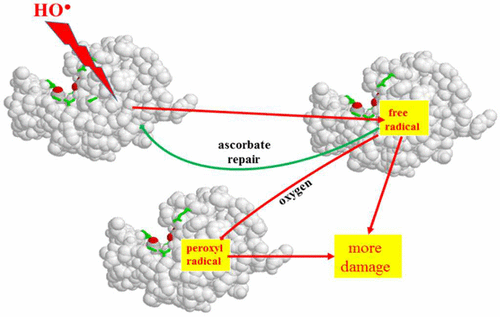当前位置:
X-MOL 学术
›
Chem. Res. Toxicol.
›
论文详情
Our official English website, www.x-mol.net, welcomes your feedback! (Note: you will need to create a separate account there.)
Physiological Concentrations of Ascorbate Cannot Prevent the Potentially Damaging Reactions of Protein Radicals in Humans
Chemical Research in Toxicology ( IF 4.1 ) Pub Date : 2017-08-29 00:00:00 , DOI: 10.1021/acs.chemrestox.7b00160 Thomas Nauser 1 , Janusz M. Gebicki 2
Chemical Research in Toxicology ( IF 4.1 ) Pub Date : 2017-08-29 00:00:00 , DOI: 10.1021/acs.chemrestox.7b00160 Thomas Nauser 1 , Janusz M. Gebicki 2
Affiliation

|
The principal initial biological targets of free radicals formed under conditions of oxidative stress are the proteins. The most common products of the interaction are carbon-centered alkyl radicals which react rapidly with oxygen to form peroxyl radicals and hydroperoxides. All these species are reactive, capable of propagating the free radical damage to enzymes, nucleic acids, lipids, and endogenous antioxidants, leading finally to the pathologies associated with oxidative stress. The best chance of preventing this chain of damage is in early repair of the protein radicals by antioxidants. Estimate of the effectiveness of the physiologically significant antioxidants requires knowledge of the antioxidant tissue concentrations and rate constants of their reaction with protein radicals. Previous studies by pulse radiolysis have shown that only ascorbate can repair the Trp and Tyr protein radicals before they form peroxyl radicals under physiological concentrations of oxygen. We have now extended this work to other protein C-centered radicals generated by hydroxyl radicals because these and many other free radicals formed under oxidative stress can produce secondary radicals on virtually any amino acid residue. Pulse radiolysis identified two classes of rate constants for reactions of protein radicals with ascorbate, a faster one in the range (9–60) × 107 M–1 s–1 and a slow one with a range of (0.5–2) × 107 M–1 s–1. These results show that ascorbate can prevent further reactions of protein radicals only in the few human tissues where its concentration exceeds about 2.5 mM.
中文翻译:

生理浓度的抗坏血酸不能阻止人类蛋白质自由基的潜在破坏性反应
在氧化应激条件下形成的自由基的主要初始生物学目标是蛋白质。相互作用的最常见产物是以碳为中心的烷基,它们与氧迅速反应形成过氧自由基和氢过氧化物。所有这些物种都是反应性的,能够传播自由基对酶,核酸,脂质和内源性抗氧化剂的破坏,最终导致与氧化应激相关的病理。预防这种破坏链的最佳机会是通过抗氧化剂对蛋白质自由基进行早期修复。估计生理上重要的抗氧化剂的有效性需要了解抗氧化剂组织的浓度以及它们与蛋白质自由基反应的速率常数。以前通过脉冲辐射分解进行的研究表明,只有抗坏血酸才能在生理浓度的氧气下形成过氧自由基之前修复Trp和Tyr蛋白自由基。现在,我们已经将这项工作扩展到了由羟基自由基产生的其他以蛋白质C为中心的自由基,因为这些和许多其他在氧化应激下形成的自由基可以在几乎任何氨基酸残基上产生二级自由基。脉冲辐射分解确定了蛋白质自由基与抗坏血酸反应的两类速率常数,在(9–60)×10范围内更快 现在,我们已经将这项工作扩展到了由羟基自由基产生的其他以蛋白质C为中心的自由基,因为这些和许多其他在氧化应激下形成的自由基可以在几乎任何氨基酸残基上产生二级自由基。脉冲辐射分解确定了蛋白质自由基与抗坏血酸反应的两类速率常数,在(9–60)×10范围内更快 现在,我们已经将这项工作扩展到了由羟基自由基产生的其他以蛋白质C为中心的自由基,因为这些和许多其他在氧化应激下形成的自由基可以在几乎任何氨基酸残基上产生二级自由基。脉冲辐射分解确定了蛋白质自由基与抗坏血酸反应的两类速率常数,在(9–60)×10范围内更快7 M –1 s –1和一个慢范围为(0.5–2)×10 7 M –1 s –1的传感器。这些结果表明,抗坏血酸仅在其浓度超过约2.5mM的少数人体组织中才能阻止蛋白质自由基的进一步反应。
更新日期:2017-08-29
中文翻译:

生理浓度的抗坏血酸不能阻止人类蛋白质自由基的潜在破坏性反应
在氧化应激条件下形成的自由基的主要初始生物学目标是蛋白质。相互作用的最常见产物是以碳为中心的烷基,它们与氧迅速反应形成过氧自由基和氢过氧化物。所有这些物种都是反应性的,能够传播自由基对酶,核酸,脂质和内源性抗氧化剂的破坏,最终导致与氧化应激相关的病理。预防这种破坏链的最佳机会是通过抗氧化剂对蛋白质自由基进行早期修复。估计生理上重要的抗氧化剂的有效性需要了解抗氧化剂组织的浓度以及它们与蛋白质自由基反应的速率常数。以前通过脉冲辐射分解进行的研究表明,只有抗坏血酸才能在生理浓度的氧气下形成过氧自由基之前修复Trp和Tyr蛋白自由基。现在,我们已经将这项工作扩展到了由羟基自由基产生的其他以蛋白质C为中心的自由基,因为这些和许多其他在氧化应激下形成的自由基可以在几乎任何氨基酸残基上产生二级自由基。脉冲辐射分解确定了蛋白质自由基与抗坏血酸反应的两类速率常数,在(9–60)×10范围内更快 现在,我们已经将这项工作扩展到了由羟基自由基产生的其他以蛋白质C为中心的自由基,因为这些和许多其他在氧化应激下形成的自由基可以在几乎任何氨基酸残基上产生二级自由基。脉冲辐射分解确定了蛋白质自由基与抗坏血酸反应的两类速率常数,在(9–60)×10范围内更快 现在,我们已经将这项工作扩展到了由羟基自由基产生的其他以蛋白质C为中心的自由基,因为这些和许多其他在氧化应激下形成的自由基可以在几乎任何氨基酸残基上产生二级自由基。脉冲辐射分解确定了蛋白质自由基与抗坏血酸反应的两类速率常数,在(9–60)×10范围内更快7 M –1 s –1和一个慢范围为(0.5–2)×10 7 M –1 s –1的传感器。这些结果表明,抗坏血酸仅在其浓度超过约2.5mM的少数人体组织中才能阻止蛋白质自由基的进一步反应。


























 京公网安备 11010802027423号
京公网安备 11010802027423号